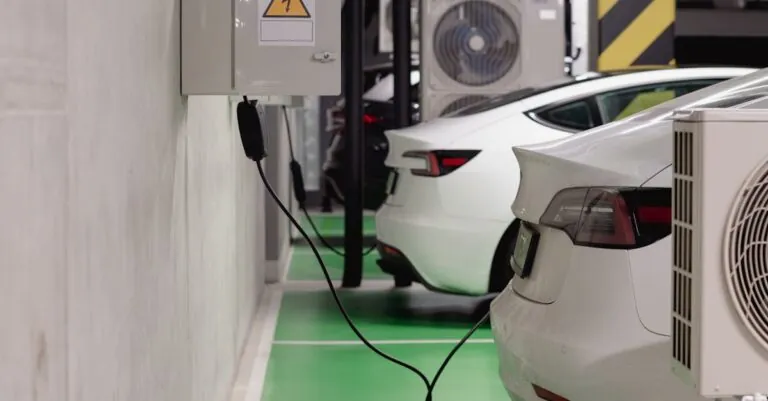As winter rolls in and temperatures drop, electric vehicle (EV) owners might find themselves in a bit of a pickle. Just when they thought they’d mastered the art of range management, Mother Nature throws a snowball into the mix. It’s no secret that cold weather can sap battery power faster than a kid can lose a mitten in a snowstorm. But just how much range do EVs actually lose when the mercury plummets?
Table of Contents
ToggleUnderstanding EV Range
Cold weather significantly impacts the range of electric vehicles (EVs). Understanding the factors influencing this range assists owners in managing their vehicles effectively during winter months.
What Affects EV Range?
Battery chemistry affects range in colder temperatures. Lithium-ion batteries lose efficiency as temperatures drop. Driving habits, such as speed and acceleration, also play a role in range reduction. Using heating systems inside the vehicle consumes additional energy, further decreasing the distance an EV can travel on a single charge. Weight from cargo or passengers influences range as well. Environmental conditions such as wind and terrain can either enhance or hinder aerodynamic efficiency. Together, these elements significantly impact total EV range.
Importance of Temperature on Range
Temperature directly correlates with battery performance. Cold temperatures can reduce battery capacity by 20% to 40%, depending on the specific chemistry used. Range loss occurs due to the increased resistance in cold batteries. Additionally, regenerative braking systems may become less effective in low temperatures. Within these conditions, charging can also take longer, making planning essential for long trips. Knowing how temperature variations affect an EV can help drivers make informed choices during winter months.
How Much Range Do EVs Lose in Winter?
Cold weather significantly affects electric vehicle (EV) range. Research indicates a drop in battery capacity ranging from 20% to 40% in low temperatures.
Statistical Insights
Data from multiple studies shows that EVs experience considerable range loss during winter months. For instance, when temperatures fall to approximately 20°F, many models can lose about 30% of their ideal range. A recent analysis of several popular EVs highlighted that some may only achieve around 70 to 80 miles per charge compared to summer performance. Additionally, driving conditions may further exacerbate this loss. High-speed driving and frequent use of heating systems contribute to increased energy consumption, compounding the effects of cold temperatures.
Variability Among Different Models
Different EV models show varied resilience against winter conditions. For example, luxury models often incorporate advanced thermal management systems, mitigating some range loss. Conversely, entry-level models might face more significant reductions in their effective range when cold weather strikes. Kia’s EV6, for instance, might show a decrease of about 25%, while Tesla’s Model 3 can retain around 10% more range due to efficient battery design. Temperature sensitivity varies by model, leading to distinct experiences for users across different brands. Consequently, understanding these differences aids EV owners in managing expectations during colder months.
Factors Contributing to Range Loss
Several factors influence how much range electric vehicles (EVs) lose in winter. Each plays a significant role in battery performance during cold weather.
Battery Chemistry
Battery chemistry determines how well an EV operates in low temperatures. Lithium-ion batteries, commonly used in EVs, lose capacity as temperatures drop. Cold weather can reduce battery output by 20% to 40%. This reduction occurs because the chemical reactions within the battery slow down. Furthermore, different EV models utilize varying battery technologies, leading to different levels of range loss. For example, some batteries are designed with additives that enhance cold weather performance, while others may not perform as reliably. Recognizing these differences helps owners understand potential range variations across models.
Heating Requirements
Heating systems significantly impact energy consumption and range during winter. Many EVs use electric heating, which can draw substantial power from the battery. Using cabin heaters frequently can lead to further reductions in driving range. In fact, operating heating systems may consume 30% or more of the available battery energy. EVs also utilize energy for front and rear defrosters, adding to the overall usage. Well-designed EVs may employ heat pumps to improve efficiency, reducing range loss. Adjusting driving habits, such as using seat warmers instead of cabin heat, can help preserve battery life during colder months.
Tips for Maximizing EV Range in Winter
Taking proactive measures greatly enhances an electric vehicle’s range during winter months. Specific techniques allow EV owners to mitigate the impact of cold weather on battery performance.
Preconditioning the Battery
Preconditioning the battery enables it to reach optimal operating temperature before driving. Many EVs provide a preconditioning feature that activates while the vehicle is still charging. Setting this function activates heating systems to warm the battery, enhancing efficiency and maximizing capacity. Doing this means reduced energy loss once on the road. This strategy not only preserves range but also helps improve charging times, making transitions smoother for owners.
Driving Techniques
Implementing smart driving techniques contributes significantly to maximizing range in colder conditions. Maintaining steady speeds rather than rapid accelerations helps conserve battery power. Utilizing regenerative braking optimally recaptures energy, leading to improved range. Opting for seat warmers instead of engaging the cabin heater minimizes energy drain. Owners should also plan routes to avoid aggressive driving conditions, which place additional strain on the battery. Prioritizing these practices ensures that electric vehicles operate more efficiently even during winter.
Winter poses unique challenges for electric vehicle owners as cold temperatures can substantially reduce battery range. By understanding the factors that contribute to this range loss, such as battery chemistry and energy consumption from heating systems, owners can better manage their expectations. Adopting strategies like preconditioning the battery and smart driving techniques can help maximize efficiency and mitigate the effects of winter weather. With careful planning and awareness, EV owners can navigate the colder months more effectively, ensuring their vehicles perform optimally despite the chill.




